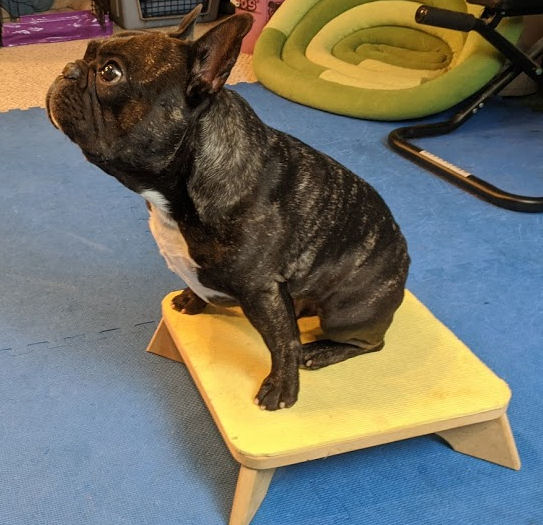Dogs need processing time, too!
When you’re having a conversation with someone and they say something unexpected, you need a moment to switch gears. That’s what we mean by processing time. Dogs need processing time, too. A chance to let the information flow from ears, to brain, to action.
Not their native language
Remember when you’re playing dog training games – English isn’t your dog’s first language. Just like any non-native speaker, it may take a moment to translate, understand, and respond. It’s perfectly normal.

Every other day, Hope’s French Bulldog Torque does his physical fitness routine of squat, crouch, sit, and stand (in a random order) across a four-inch-high stool. Each of those instructions describes a very specific action.
- Squat means step off the front of the stool with your front paws and bend your back legs into sit position.
- Crouch is step off the back of the stool and bend your back legs into a sit position.
- Sit means sit with your whole self on the stool.
- Stand means stand, all four feet on the stool.
Each time they do this routine, Hope can tell how focused Torque is by how quickly he responds to the various commands. Some days, he’s sharp as a tack and instantly moves smoothly from one position to another.
Other days? We say he “doesn’t have his ears on” when he reacts like he’s never heard the word “sit” before. He has. Millions of times.
Processing time
Most days, however, it takes a beat or two. Torque hears the word and you can almost see the cogs meshing as he processes the information. He gets the time he needs to think it through.
Most people want their dogs to succeed, so they jump in to “help” whenever their dogs seem slow to respond. What the dog learns is to wait and let “mom” do the work.
Like many people, dogs are essentially lazy. If someone wants to do the task for them, most dogs are more than happy to let them. The more you “help” your dog, the more helpless they become. Instead, try giving them time to process and get it right,
Tough to remember
Being patient and just waiting is really hard. How long do you wait before you repeat the command? How long is long enough?
The answer depends on the dog and you. The best way to tell is to watch your dog and see if he/she is still trying and thinking, or if they’ve checked out on the task.
When dogs don’t understand what’s being asked, they tend to look for ways to escape. Wandering away, looking away, barking, jumping, scratching, are all ways dogs have of telling us they don’t know. They’re confused and uncomfortable.
If you consistently get this reaction for a particular game, go back to an earlier step in the training. Even if it’s back to the beginning – that’s okay. Sometimes we all need refreshers on stuff we used to know.
Learning a foreign language
Your dog is learning a foreign language. Just like people, younger dogs tend to learn faster than adult dogs. It doesn’t mean that you can’t teach an old dog new tricks.
It just means they need a bit more time to process. Translating what you say into actions they perform is a small miracle our dogs achieve each and every day. It’s no wonder dogs need processing time. Give it to them.







One thought on “Dogs need processing time, too!”
Comments are closed.